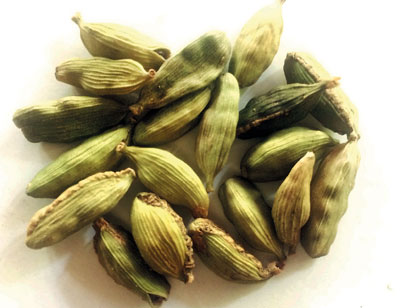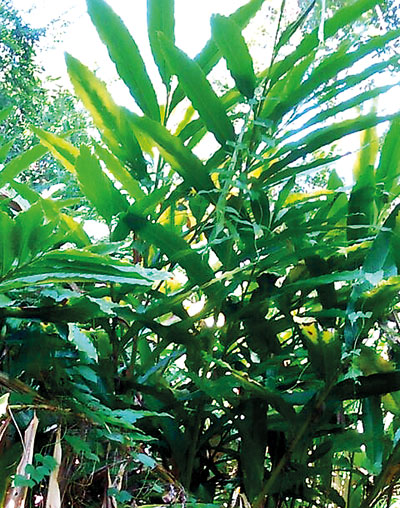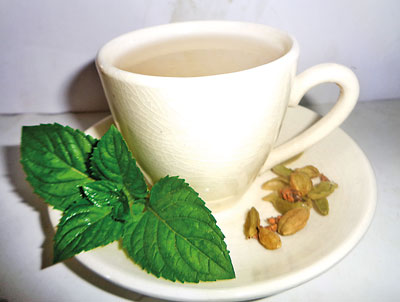The Queen of Spices reigns over many health benefits
Cardamom, Enasal or Karadamungu in Sinhalese, ĒElakkay in Tamil is the third most expensive spice in the spice market, behind only saffron and vanilla. Also known as the ‘Queen of spices’ or ‘Grain of paradise’, cardamom, Elettaria cardamomum, is a small spindle-shaped green seed pod with a thin, yet tough, papery outer cover. The pod has three chambers filled with about 10 to 20 small dark brown to black seeds.
 Cardamom is well known for its very strong aromatic flavour and aroma which is usually described as smoky, floral, citrus and sweet and can often dominate other spices in culinary applications. A member of the family Zingiberaceae, cardamom is a ginger-type plant with rigid and erect aromatic leaves. However cardamom plants are huge in comparison to its relatives ginger, turmeric and galangal and unlike these whose rhizomes are the important part,cardamom is best known for the flavour found in the seeds.The pods that are borne on inflorescences are hand-picked just before ripening.
Cardamom is well known for its very strong aromatic flavour and aroma which is usually described as smoky, floral, citrus and sweet and can often dominate other spices in culinary applications. A member of the family Zingiberaceae, cardamom is a ginger-type plant with rigid and erect aromatic leaves. However cardamom plants are huge in comparison to its relatives ginger, turmeric and galangal and unlike these whose rhizomes are the important part,cardamom is best known for the flavour found in the seeds.The pods that are borne on inflorescences are hand-picked just before ripening.
In Sri Lanka, cardamom is found mainly in the hill country with Kandy, Matale, Kegalle, Nuwara Eliya, Ratnapura and a part of Galle being the major growing districts. Three varieties are commonly grown where the Malabar, Mysore and Vazhukka types have inflorescences that are vertical, prostrate and inclined respectively. An organic cardamom is also produced by a selected group of cultivators for the local and global markets. Moreover, a green, larger, triangular cardamom pods, indigenous to Sri Lanka, has been categorized as the Ceylon cardamom in the global spice market.
Cardamom types
Green cardamom–Green cardamom is produced by drying freshly picked seedpods in hot air barns under controlled conditions and is known as ‘green curing’. Dark green cardamoms are the finest and most expensive due to their superior and most vibrant flavour and aroma. The colour can vary from light green to buff depending on drying and storage conditions.
 White cardamom – Are green pods that have been bleached for aesthetic purposes for use in light coloured breads, batters etc. The bleaching process diminishes some of the flavour, so avoid this unless a uniform light colour is required.
White cardamom – Are green pods that have been bleached for aesthetic purposes for use in light coloured breads, batters etc. The bleaching process diminishes some of the flavour, so avoid this unless a uniform light colour is required.
Using cardamom
Whole pods are best used in cooking that has some liquid for the cardamom to infuse. Crush the pods slightly to expose the seeds inside. The pods may be removed from the dish before serving, or you can take them out while eating. It will be easier to remove if you bundle crushed pods in a muslin cloth and then insert to the cooking liquid.
Ground cardamom is used in recipes where whole pods or seeds are undesirable such as in drinks, sweets and desserts. A little ground cardamom has a considerable effect, particularly if freshly ground, so use it sparingly.
Quality
The quality of cardamom with respect to odour, flavour and health benefits is mainly determined by the content and composition of its essential oil which is present in the range of 2 to 5% of the seed. Consisting of a majority of monoterpenes with the predominant one being 1,8-cineole, it also comprises of esters, alcohols and sesquiterpenes. In addition to these phyto-nutrients cardamom contains niacin, riboflavin, vitamin C, potassium, iron, manganese, magnesium, copper and zinc.
Always store cardamom in a tightly sealed jar in a cool dry place away from sunlight to retain flavour and potency.
Culinary uses
Cardamom enhances both sweet and savoury flavours. It is commonly used to flavour meats, poultry, seafood, vegetable dishes, soups and sauces. It is a must for yellow rice and hot beef and chicken curries. Cardamom is used in the Indian spice mix, garam masala that flavours biriyanis, curries, snacks, and other savouries.Ground cardamom is added to herbal infusions, Turkish coffee, lattes, and festive drinks.
Cardamom is the chief flavouring ingredient in Indian sweetslike kheer and gulab jamun and is also a must in the spice mix together with cloves and cinnamon for love cake, jaggery cake and Christmas cake.It is also used in desserts such as watalappan, rice pudding, flans, fruit pies, porridge, ice cream and is great in delicate chocolate preparations containing a splash of cocoa powder. Always be careful as too much cardamom can easily overwhelm and ruin a dish.
Health benefits Aids digestion
Cardamom is a natural digestive enhancer andstimulates the stomach, gall bladder and salivary glands. It also helps to prevent feelings of fullness and abdominal bloating.
Prevents bad breath
Cardamom helps in neutralizing dental bacteria getting rid of bad breath and also preventing cavity formation. It is best to chew on the pod, which will contribute towards teeth whitening as well.
Regularizes heart rate
Packed with minerals, cardamom is a perfect for essential electrolytes and with its good supply of potassium it helps regularize heart rate and blood pressure.
Detoxifies body and fights free radicals
Cardamom is a very effective detoxifier combating ill effects of toxin accumulation. Further, it scavenges and destroys free radicals thus having impacts on conditions like premature aging, rheumatism and some fatal conditions such as cancer.
Supports weight loss
Cardamom boosts metabolism and helps the body burn fat more efficiently.
Treats sleep problems and is an anti-depressant
Inhaling the sweet and soothing aroma of cardamom may help in treating sleep issues such as insomnia, restlessness, and anxiety. Cardamom oil has cineole that aids in soothing the nervous system, calming down the muscles and alleviating tension. This is why cardamom essential oil is one of the major oils used in aromatherapy.
Fights anaemia
Some major components of cardamom that include copper, iron, niacin, riboflavin and vitamin C play an important role in the production of red blood cells and cellular metabolism and thus plays a role in fighting anaemia.
Treats sore throat, nausea and vomiting
Cardamom is an effective tonic and stimulant and is good for calming the sensations of nausea and vomiting. Cardamom also acts as a good remedy for sore throat. Boil cardamom and cinnamon together and use as a gargle.
Alleviates symptoms of respiratory illnesses
Cardamom works wonders in regulating the circulation of blood within your lungs and rejuvenating the entire system, thereby aiding in relieving symptoms of bronchitis, asthma, cold and cough.
Good for diabetes
Cardamom has a high level of manganese, making it a good choice for those who worry about blood sugar levels. Coupling it with cinnamon a diabetic-friendly spice, in an unsweetened tea is a healthy refresher.
| Cardamom Tea Cardamom tea has many health benefits and is very easy to make. Add some crushed cardamom seeds, a few cloves and peppercorns and a cinnamon stick, to boiling water, lower heat and let it simmer for 5 to 10 minutes. Remove from heat, strain and add sugar or honey if desired. You can also scoop out the seeds crush them gently and add to your cup of tea, coffee or milk to give a fragrant twist to your daily drink.  | |


